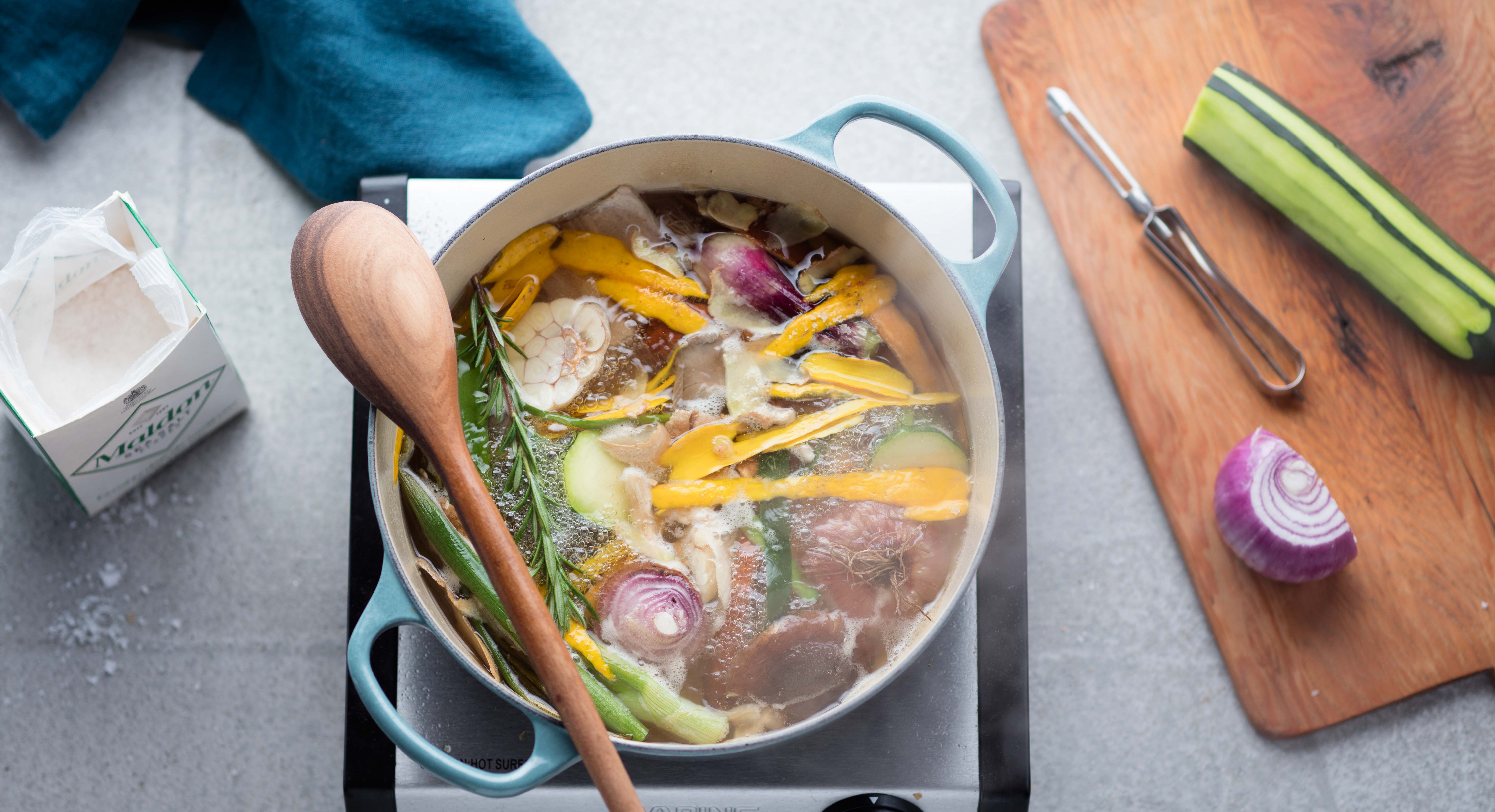Kitchen Hack: How to Make Vegetable Broth From Cooking Scraps
Last Update: September 29, 2022
The best recipes always seem a little bit magical.
Think of flour and plain water coming together in the form of a crusty, chewy loaf of bread. And how did the first cooks explain cheese, if not as some wizardry that turns spoiling milk into this salty, briny block of feta?
Classic vegetable stock comes to mind as another one of these almost unbelievable transformations. The savory liquid can improve the flavor profile of anything from risotto to pot pie, and it’s nothing more than vegetables—or even their scraps—simmered in water.
And practicing this type of magic at home is totally easy: Collect some onion skins, carrot peels, and celery tips, throw them in a pot of simmering water, and an hour later, you’ll have broth. It’s a transformation worthy of an abracadabra. Though most traditional recipes call for whole or chopped vegetables, scraps work just as well—and help save you money and eliminate food waste. Here’s how to try this eco-friendly technique at home.
1. Start saving scraps.
Here’s where it gets fun. See those papery onion skins? The carrot tops and peels, beet greens, kale and mushroom stems, and celery leaves you’d normally compost or toss? Save them all in a gallon-sized ziplock bag in the freezer until you have several cups worth of scraps. See ya never, food waste!
Don’t forget herbs and other common leftovers, either. Parsley stems, wilted thyme, and anything else not fit for garnishing will taste just fine in your broth. Leftover Parmesan rinds add some much need umami, too—the kind of flavor you’d normally get from meat or bones.
This isn’t carte blanche to save all trash, though. Anything moldy, covered in dirt, or otherwise unsafe to eat should never go into a broth. Skip most cruciferous veggies like broccoli, cauliflower, Brussels sprouts, and cabbage, though—they’ll leave your broth bitter. Potatoes aren’t any good either—the starch will just turn everything cloudy.
2. Prepare your vegetables.
Take your scraps out of the freezer, and give ’em a good once over. For a full-bodied broth, you need lots of onion, carrot, and celery—chop up a few fresh ones if you need to. You’ll want 6 or 7 cups of veggies total.
If you’re willing to put in a few extra minutes of effort, sweat all the vegetables in the bottom of your pot with a little olive oil. This helps release more of their flavors, and leads to a deeper broth. In a rush? Skip this step—the finished broth will still come out great.
Add 8 cups of water to the pot, and bring it to a simmer.

3. Season the pot.
Ever wondered about the difference between stock and broth? The two terms are often used interchangeably, but according to The Kitchn, there are a couple of key differences: stocks always include some kind of bones and are usually left unseasoned, while broth can be meat-based or vegetarian and is typically seasoned. (To make matters more confusing, what is most commonly known as bone broth, though sometimes called “bone stock,” is—technically—a stock).
We’re making a broth here, so go ahead and add a teaspoon of salt and any other seasonings you’d like to the liquid. Default to the classics—peppercorns for gentle heat, bay leaves for comforting herbal notes, fennel seeds for an aromatic, licorice flavor—or experiment with your favorites.
4. Simmer, simmer, simmer.
Partially cover the pot, and—wait for it—leave it alone for at least an hour. Check on it from time to time to make sure it’s still simmering (and not bubbling over). As the water simmers, it draws out all the flavor of the vegetables, and the longer you let it go, the more flavorful it’ll come out. If you have time, let it cook for up to 4 hours—the result will be worth it.
5. Strain, then store.
There’s only one step left: Strain the liquid through a colander or fine mesh strainer to remove the vegetable solids, and taste! The finished broth can be used for so many things: cooking risotto, whipping up homemade gravy, making stews and soups, and any recipe that calls for chicken stock.
Pour the broth into several mason jars, and freeze a few to use throughout the year. Feeling accomplished? You should be!
Photo credit: Paul Delmont
This article is related to:
Bone Broth Recipes, Cooking Questions, Cooking Tips, DIY, Food Hacks, Gluten-Free, Paleo, Vegan, VegetarianThis site is protected by reCAPTCHA and the Google Privacy Policy and Terms of Service apply.



